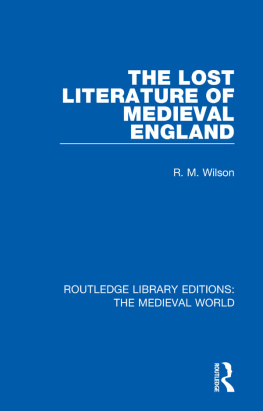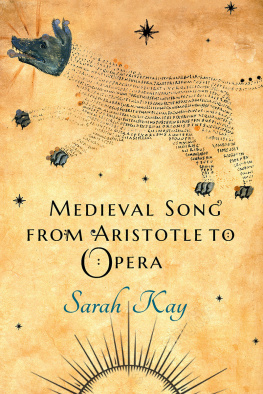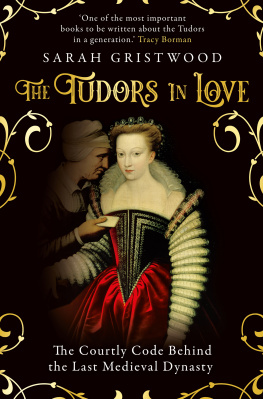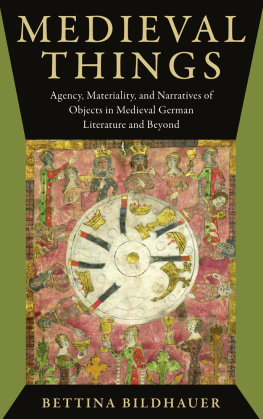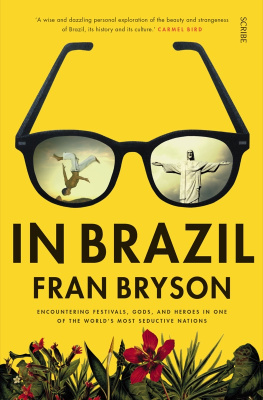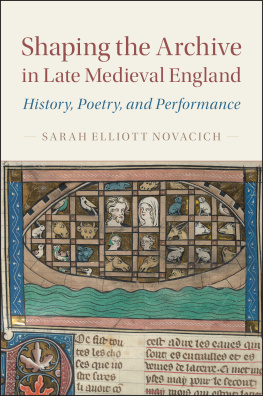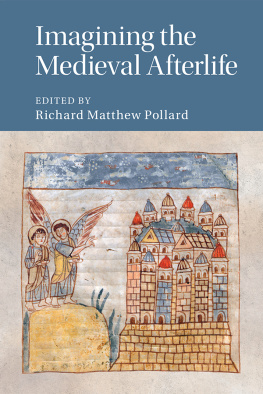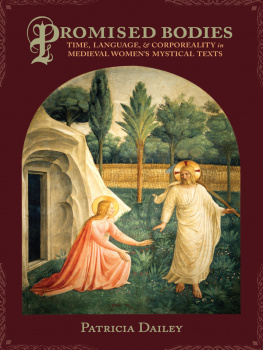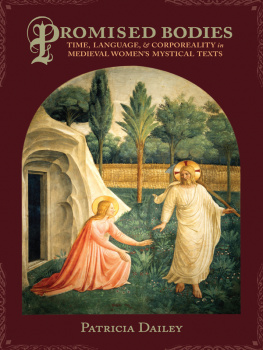The Corporeality of Clothing in Medieval
Literature
EARLY DRAMA, ART, AND MUSIC
Series Editors
David Bevington
University of Chicago
Robert Clark
Kansas State University
Jesse Hurlbut
Independent Scholar
Alexandra Johnston
University of Toronto
Veronique B. Plesch
Colby College ME
Medieval Institute Publications is a program of
The Medieval Institute, College of Arts and Sciences

W ESTERN M ICHIGAN U NIVERSITY

Copyright 2018 Walter de Gruyter GmbH, Berlin/Boston
Library of Congress Cataloging-in-Publication Data
are available from the Library of Congress
ISBN: 9781580443579
eISBN: 9781580443586
All rights reserved. Without limiting the rights under copyright reserved above, no part of this book may be reproduced, stored in, or introduced into a retrieval system, or transmitted, in any form, or by any means (electronic, mechanical, photocopying, recording or otherwise) without the written permission of both the copyright owner and the author of the book.
Every effort has been made to obtain permission to use all copyrighted illustrations reproduced in this book. Nonetheless, whosoever believes to have rights to this material is advised to contact the publisher.
Abbreviations
| EDAM | Early Drama, Art, and Music |
| EETS | Early English Text Society |
| CCCM | Corpus Christianorum Continuatio Mediaevalis |
| CCSL | Corpus Christianorum Series Latina |
| DMLBS | Dictionary of Medieval Latin British Sources
www.dmlbs.ox.ac.uk/ |
| MED | Middle English Dictionary
http://quod.lib.edu/m/med/ |
| MHRA | Modern Humanities Research Association |
| NPNF | Nicene and Post Nicene Fathers |
| PG | Patrologiae Cursus Completus. Series Graeca |
| PL | Patrologiae Cursus Completus. Series Latina |
| REED | Records of Early English Drama |
| RSA | Renaissance Society of America |
Acknowledgments
T HIS BOOK IS AN extension of my doctoral thesis, and so has been a long time in the making. The list of supporters has grown with the years and far exceeds the scope of these acknowledgments. I thank Pamela King for her generous guidance as commissioning editor, and for making this process so seamless. I also thank the staff at MIP for their help with the preparation of the manuscript. Thanks to Guillemette Bolens for believing in my work, for guiding me intellectually over the years, and for being such a relentless advocate for the value of literature. To those present on the jury of my viva in 2015, Pamela King, Sarah-Grace Heller, and Elizabeth Robertson, your comments have been instrumental to my reshaping of that work into this book. Thanks also to Lukas Erne, for being supportive and critical at the right moments over the years.
I am grateful to many of my fantastic colleagues at the University of Geneva, who have provided a well of inspiration over the yearsOliver Morgan, Susie Gebhardt, Ioana Balgradean, Amy Brown, Devani Singh, Mary Flannery, Mark DArcy, Juliette Vuille. A second thanks goes to those who have been so kind as to read versions of the chapters. Oliver, Max, Devani, Susie, Mary, Mark, and Yassin, your suggestions have helped me to improve this work both conceptually and editorially.
I have also benefitted from support from colleagues in the UK and US, whose work and kindness have been equally influential. I thank particularly Max Harris, Sarah-Grace Heller, Pamela King, and Greg Walker. I am extremely grateful to early English drama studies in its many forms, SITM, MeTh, REED, MRDS, for always welcoming new members warmly. Alexandra Johnston has been exemplary in this regard. Thanks to Charlotte Steenbrugge for her kind support and advice, and to Camille Marshall for sharing her work on the Towneley manuscript. Thanks to the reader of the manuscript, whose comments were insightful and helpful in getting the book ready for publication. Thanks to my brilliant students in Geneva, especially at Masters level, who have humored me by taking classes on medieval clothing and other strange topics.
The rest of my thanks must go to my family, whose relentless belief in my work has sustained me more than my own. To Michael, Rachel, and Martha, to our mother Helen, who we lost seven years ago, to Breda and John, to Karin, to Ruadhn, and finally, to my endlessly patient and supportive husband, Yassin. This book is for all of you.
Introduction
I N THE ELEVENTH-CENTURY TRANSLATIO Edithe , an otherwise exemplary monk performs a transgressive act upon the corpse of the English saint. In seeking a relic of the holy body, Eadwulf of Glastonbury takes a knife and proceeds to cut off a piece of Ediths clothing. In the midst of doing so, the blade makes contact with the saints breast, causing blood to gush forth. Ediths white clothes become soaked in blood, which flows as far as the paved floor below. The terrified monk drops the cloth and knife, and quickly performs penance. The blood then recedes, as if by miracle. All is as it was, and the monk is duly chastened against the illicit acquisition of relics.
In such a narrative, where does Ediths body begin and end? To what extent can it be said that her clothing, white to signify her status as a bride of Christ, is part of her saintly body schema, both in terms of her spiritual perfection and her corporeality? Looking more closely at Goscelin of Saint Bertins (b. 1040?) hagiographic account is a good way to think more about this question, because the writer includes several anomalies in his text. First, the piece of cloth Eadwulf cuts is specified as a fold or crease ( ruga ). but in relation to a weapon suggests a mere grazing of the skin. Such an action is unlikely to result in profuse bleeding. Less likely still is that the graze would cause such a response from a dead body, or a living one for that matter. But physiological norms are not being measured in this translatio . The body of Edith responds to the monks transgression in a suitable fashion, and the gushing blood facilitates Eadwulf s reflexive faculties, allowing him to recognize his spiritual failures and atone for them.
In order to achieve this outcome, body and cloth co-participate in an extreme physiological response. The cutting off of a piece of cloth the blades contact with the body is notably diminished to a graze, insufficient to cause violent bleeding. But again, Goscelin takes pains to clarify that cutting Ediths clothes is the same as cutting her body, and the response is one not warranted by the physical act but by the extent of the transgression.
The question of where Ediths body ends and her clothing begins is one that Goscelin forces the reader to consider. Embedded within a prospective answer is that no precise boundary between cloth and body can be determined. Such a conclusion underwrites the basic premise of sainthood, which is permeable and, above all, does not limit holiness to the material body of the saint. This functionality guarantees the sanctity of the relic, such as the one Eadwulf was trying to acquire, but it also opens up wider questions about conceptual relationships between the body and its material environment in the medieval period. The idea that artifacts such as clothing can co-participate with the body in profound ways has recently been explored from a variety of methodological perspectives. Numerous critics have issued challenges to accepted delimitations to what might be termed the body proper.


 W ESTERN M ICHIGAN U NIVERSITY
W ESTERN M ICHIGAN U NIVERSITY

